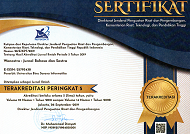PENERJEMAHAN HARFIAH: DOMINASI DALAM TEKNIK PENERJEMAHAN SURAT INFORMAL
Abstract
Translation techniques are expected to be solutions to cope with translation problems faced by translators. Due to this reason, translation learners are taught these techniques to be their provision in handling translation problems they will face as professional translators. This research is aimed at giving comprehension of the using translation techniques tendency in informal letter translation. Case study method is used in this research to analyze how English Letters students who have learnt translation through qualitative approach and document data collecting technique. This research uses Molina & Albir's (2002)Translation Techniques to identify the translation technniques used by the students.The result shows that the dominance of literal translation technique by a very significant data finding from the eleven techniques used with normal distribution ranging from 17 until 27 data per students.In the next research, it is hoped that there will be wider scope of study to analyze the trends of translation techniques in those students’ affiliation.
Keywords: Literal Translation, Teknik Penerjemahan, Informal Letter
Full Text:
PDF (Bahasa Indonesia)References
Basnett, S. (2002). Translation Studies. In Year’s Work in Critical and Cultural Theory (3rd ed.). https://doi.org/10.1093/ywcct/mbw001
Catford, J. . (1965). A Linguistic Theory of Translation. London: Oxford Univesity Press.
Gentzler, E. (2004). Contemporary Translation Theories. Shanghai: Shanghai Foreign Language Education Press.
Hidayat, A., & Harmoko, D. D. (2018). Parafrasa dalam Terjemahan Novel Peebee Has A Wish. Retorika UNM, 11(1), 1–13. Retrieved from http://ojs.unm.ac.id/retorika/article/view/4962/pdf_16
JCPS. (2006). Letter Writing (F. Richardson, ed.). Retrieved from https://pdst.ie/sites/default/files/7590_Letter_Writing_Book.pdf
Mardiana, W. (2015). Teknik Transposisi dan Modulasi: Kesepadanan dan Pergeseran dalam Penerjemahan Cerpen. PAROLE: Journal of Linguistics and Education, 4(2), 120–130. https://doi.org/https://doi.org/10.14710/parole.v4i2%20Oct.120-130
Molina, L., & Albir, A. H. (2002). Translation techniques revisited: A dynamic and functionalist approach. Meta, 47(4), 498–512. https://doi.org/10.7202/008033ar
Mujiyanto, Y. (2011). Strategies in Translation Practices. In TLS - The Times Literary Supplement. https://doi.org/10.2307/j.ctt9qh8h1.53
Nida, E. A., & Taber, C. (1969). The Theory and Practice of Translation. Leiden: Brill.
Nord, C. (2007). Translating as a Purposeful Activity: Functionalist Approaches Explained. Manchester: St. Jerome Publishing.
Oettinger, A. G. (1960). Automatic Language Translation, Lexical and Technical Aspects, with Particular Reference to Russian. Cambridge: Harcard University Press.
Rahma, A., Kristina, D., & Marmanto, S. (2018). Analisis Teknik Penerjemahan Adaptasi Dan Variasi Pada Subtitle Film Batman Versi Bahasa Jawa Mataraman. PRASASTI: Journal of Linguistics, 3(1), 13. https://doi.org/10.20961/prasasti.v3i1.19664
Shuping, R. (2013). Translation as Rewriting. International Journal of Humanities and Social Science, 3(18), 55–59. Retrieved from http://ijhssnet.com/journals/Vol_3_No_18_October_2013/6.pdf
Wills, W. (1977). Übersetzungswissenschaft. Probleme und Methoden. In English translation as Translation Science. Problems and Methods. Tübingen: Narr.
Zhang, T. (2011). Politeness Principle in the Translation of Business Letters. Theory and Practice in Language Studies, 1(6), 615–621. https://doi.org/10.4304/tpls.1.6.615-621
DOI: https://doi.org/10.31294/w.v12i1.7596
Copyright (c) 2020 Arif Hidayat

This work is licensed under a Creative Commons Attribution-ShareAlike 4.0 International License.
Index by:
Published by Department of Research and Community Service (LPPM) Universitas Bina Sarana Informatika by supported Relawan Jurnal Indonesia
Jl. Kramat Raya No.98, Kwitang, Kec. Senen, Jakarta Pusat, DKI Jakarta 10450

This work is licensed under a Creative Commons Attribution-ShareAlike 4.0 International License






